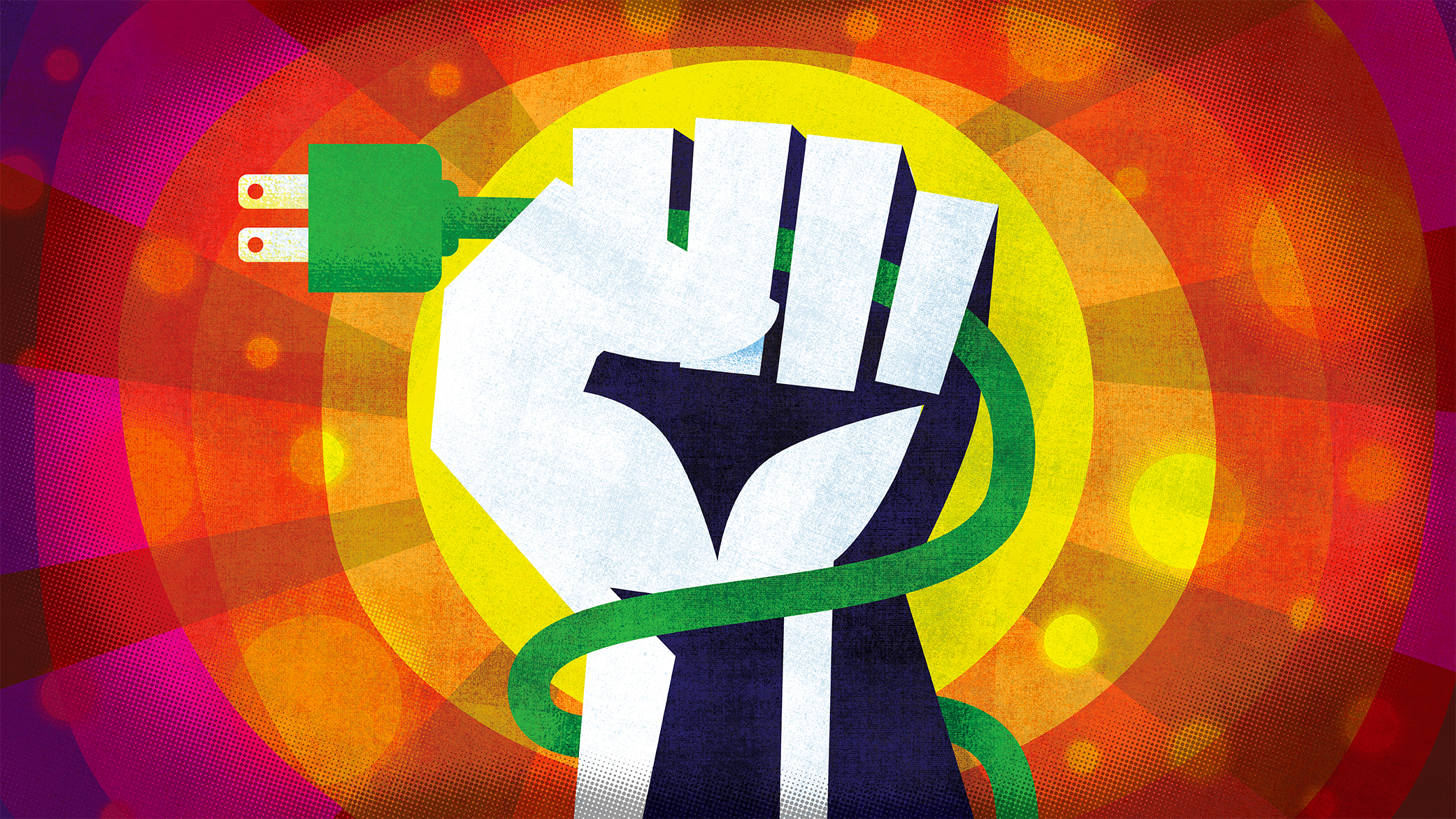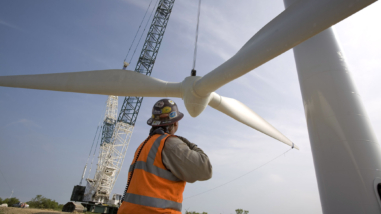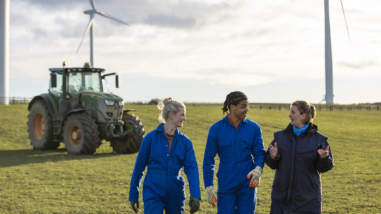This is the final installation in a series by Hewlett Environment Program Officer Erin Rogers about what charitable philanthropists and nonprofits are learning about ways to convert widespread public support for clean energy and other climate solutions into policy action that can ensure a safer climate for all. Looking at – and beyond – Hewlett’s own grantmaking, Erin shares bright spots where groups are working together to build what academics call “political will” – the complex ecosystem of social forces that help decision makers prioritize problem-solving.
Read Part one: Building political will for climate action
Read Part two: Depolarizing climate action through supporting diverse ecosystems of organizations
Read Part three: Connection, cooperation, collaboration
Read Part four: The heart-mind connection
When I first moved to California, part of my job with the Union of Concerned Scientists entailed advocating for strong design of California’s cap and trade program. I was able to work with a group of equity advocates who succeeded in amending the program to require at least 25 percent of the cap and trade revenue be invested in emission reduction efforts benefitting disadvantaged communities.[1]
Thanks to those advocates, more than $1 billion – about half of which has gone to transportation projects like electric public transit systems, affordable housing near transit, heavy duty zero-emission trucks and buses, car shares for low-income families, vanpools for migrant farm workers, and safe bike and pedestrian lanes – has now been invested specifically in disadvantaged communities throughout the state, with more to come.
It’s those very equity provisions that have had many positive ripple effects that helped build political will for further action.
When oil companies and other powerful opponents of climate action tried to dismantle the cap and trade program (several times), they failed, in part, because the program had built widespread support through the equity provisions, which are very popular. Expanding clean transportation options in underserved and over-polluted communities is not only reducing global warming pollution, but is also improving air quality and health and providing better access to good schools, jobs, and health care, which in turn has a ripple effect of decreasing health costs and increasing economic growth for all.
Embedding an equity approach to climate solutions can “multi-solve,” or address many systemic barriers at once. Instead of defining the problem narrowly (i.e. excess carbon emissions), the problem is expanded and therefore addressed in more meaningful ways. It’s what environmental activist, poet, and farmer Wendell Berry calls “solving for pattern:” avoiding solutions that inadvertently have negative side effects, and instead finding solutions that provide a wide array of benefits.
“Outsize benefits accrue to everyone from policies and investments designed to achieve equity,” explains Angela Glover Blackwell, CEO of PolicyLink. [2] “When we create the circumstances that allow those who have been left behind to participate and contribute fully – everyone wins. When we ignore the challenges faced by the most vulnerable among us, those challenges, magnified many times over, become a drag on economic growth, prosperity, and economic well-being.”
Many nonprofit organizations are embedding equity into climate campaigns in ways that create a virtuous cycle spiraling toward fostering greater political will. Embedding equity allows climate campaigns to express a hopeful vision for the future in which all boats rise (and not due to climate-induced ocean warming!) Without an equity awareness, climate solutions risk exacerbating the same economic marginalization and exclusion of low-income Americans and people of color that has happened throughout U.S. history, thus undermining the broad and deep support for the rapid transition away from fossil to clean energy that’s needed.
I’m learning a lot from the BlueGreen Alliance Foundation (BGA), which represents labor and environmental groups. BGA recently conducted listening sessions in the Midwest with rank-and-file union members. What they heard was that these workers have been feeling abandoned for decades. They are fearful of the rising costs of health care, jobs that seem to leave their local area and aren’t coming back, and promises of help that always seem to be made in words but not kept in action. Many see no difference between the major political parties, which, in their eyes, are both run by elites who are beholden to corporate interests that are fighting against each other and not looking out for working people.
So, BGA is working with labor, environmental, and community-organizing groups to find ways to collectively acknowledge and address these anxieties through climate policy campaigns that are grounded in a positive vision for a future that combines good jobs, a clean economy, and a healthy climate. They are finding that climate policies that are not solely focused on tons of emission reductions, but instead address deeper values and aspirations, gain more traction and build broader support.
One example of this kind of policy is the Buy Clean California program, which, starting in 2019, will require the state to consider the carbon footprint of the steel, glass, iron, and brass it purchases for infrastructure projects. Emissions from steel-making furnaces are a huge source of carbon pollution – around five percent of global totals. Using electric furnaces to melt recycled scrap metal, and using local manufacturers (to reduce transportation emissions) can cut emissions in half. Unions representing steel and iron workers support the program because it will help level the playing field for local, low-carbon manufacturers and their workers. Environmental groups also support the program because it allows the state to use its purchasing power to motivate manufacturers to invest millions in pollution reduction to be competitive in a market worth billions.
Another group that embraces an equity-based approach to climate solutions is the Climate and Clean Energy Equity Fund, a relatively new operating foundation focused on supporting community-based groups working on climate solutions through an equity lens. It is one of many groups bringing previously ignored perspectives into state policy discussions and helping to shape climate solutions in ways that benefit both the most vulnerable and the public at large.
For instance, in Virginia, Climate and Clean Energy Equity Fund grantee New Virginia Majority recently won an important provision in a policy governing the state’s largest utility, protecting consumers from the company’s attempts to “double-dip” and charge ratepayers twice for various improvement projects. These consumer and low-income ratepayer protection provisions helped strengthen a policy that clean energy advocates had worked on for years, in turn helping to achieve bipartisan support for the package. This collective effort will ultimately deliver more than $1 billion in new energy efficiency investments, funding for existing energy efficiency and low-income weatherization programs, and more than 5,000 megawatts of new renewable energy, much of it delivered four years faster than the utility had originally proposed. [3]
A final example is the NAACP’s Environmental and Climate Justice program. In 2015 in Mississippi, the NAACP and its community members channeled their focus on equity into closing a local coal plant that was harming the health of local NAACP members. The Sierra Club had, for years, led the fight to close the antiquated facility. The NAACP infused new voices and perspectives into the effort, highlighting energy and climate change as civil rights issues, not just environmental issues.
The NAACP released a Coal Blooded scorecard, which gave the coal plant a D- grade, and gathered clergy, teachers, health professionals, business people, elected officials, and others to discuss the impacts of coal toxins in the air. Eighteen months later, thanks in part to the broad coalition that came together around the equity imperatives, the utilities stopped burning coal in the Jack Watson (MS) and Greene County (AL) coal plants, ceased their opposition to net-metering policies; and invested $15 million in energy efficiency programming for low-income households.
Kathy Egland, Gulfport NAACP member, said that, “this victory is important not only for those of us living within a 30 miles radius of Plant Watson, but for the people of Mississippi; and in the aggregate, ultimately has implications for our entire global ecosystem.”
Indeed. Indeed. Social equity and environmental progress go hand in hand.
While much greater forces will be needed to decrease extreme social, racial, and economic inequity and protect the planet from extreme climate change, making equity a central plank of climate solutions is at least one set of oars rowing in the right direction. Philanthropy can support groups working to develop policy agendas that build hope, inspiration, dignity, unity, and prosperity across racial, class, and gender divides, instead of further exacerbating divisions. Climate advocates can move beyond the “identity politics” versus “economic populism” debate to create powerful cross-racial, cross-class coalitions that support economic opportunity and good jobs, and make specific steps to improve the conditions of people of color. In doing so, we can build the political will needed to shift away from fossil fuels and toward clean energy sources in time to avoid increasingly intense climate change-induced suffering, and instead improve quality of life for us all.




